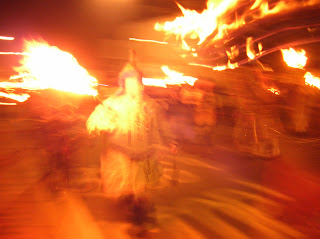Last Friday the Whirly Band took to the streets of Oxford once again to mark the Day of the Dead. It was our most successful yet, with a large crowd of up-for-it people shaking their bones and generally celebrating this dark corner of the year. I was pleased to see that more people came in costume or with face-paint than ever before. It's starting to grow.
Kate Raworth was on hand to take photos - here's a couple. There's more on her website.
For bonfire night I finally made it to Lewes, whose November the fifth celebrations are somewhat notorious. Many thanks to Philip and Stephanie Carr-Gomm for putting me up and giving me the tour.
Things begin in the early evening when the seven bonfire societies, each of which have their own firework display, join together and process up and down the narrow High Street.
The standard costume of the bonfire boys is white trousers, stripey jumper and red neckerchief.
But many people parade in costume. In fact, so many eras and styles are represented that you're left wondering whether someone accidentally stumbled on the key to the fancy dress shop. I saw Romans, Elizabethans, flouncing dandies from the court of Louis XIV, pirates (lots of pirates), a green man, Gandalf, goths, steampunks, and priests (lots of priests).
The origin of Bonfire Night is, of course, the Catholic Gunpowder Plot of 1605, and an anti-Catholic thread still runs through the Lewes celebrations. People carry banners calling for No Popery, and seventeen burning crosses are held aloft to remember Protestant Martyrs burned at the stake in the sixteenth century. It's an image that carries some rather alarming cultural connotations.
Indeed, at first glance Lewes Bonfire Night appears to be a deeply conservative, even reactionary, event, one sailing dangerously close to the unpleasant end of British nationalism. Many participants come in military costume; royalist sentiments are expressed; some people even 'black-up'. Oh deary me.
But I think such a reading is too simplistic. Amid all this order are some genuinely carnivalesque moments. The people dressed as priests are not having a pop at popery so much as mocking the pomposity of all organised religion. Yes, this is an expression of local pride and identity, but it's also two fingers to authority: try and stop us if you dare. Any councilor who tries to reign it in will find it's their effigy burning on the fires and that an election drubbing awaits.
Yes, this is a carefully orchestrated fire show, one where the police are issued with safety goggles, a piece of managed disorder, but the pressing crowds, the drunkenness, the omnipresent smell of skunk, the flares and the strings of fire-crackers thrown at participants' feet, create an exciting, even crazed, atmosphere. It certainly feels dangerous, as if anything could happen.
And the Societies that dress as 'Zulus' or 'Red Indians' claim that they have always done so to raise awareness of, and show support for, oppressed indigenes (that may be spurious, I don't know, but it is at least a move in the right direction).
After the procession, each of the Societies make their way to their traditional pitches. I went to Commercial Square. First they lit their massive bonfire.
Then, in a truly carnivalesque moment, mock priests delivered mock prayers and mock sermons from a raised platform, replete with burning crosses, to the bonfire boys gathered below. The congregation responded with a hail of bangers and squibs. The priests shrugged off this barrage with a nonchalant sang-froid, an extraordinary image. And then the fireworks went off all around them.
The display was fantastic, perhaps the best I've seen, and was remarkable for its proximity. At times we were right underneath the rockets. Shock waves pummeled me in the chest. Burning debris fell all around.
In the end, I think that what makes Lewes so wonderful is that for just one night, the ordinary quotidian is shattered. Businesses board up their windows. People down tools, take to the streets and, work-be-buggered, have a party. Most municipal firework displays no longer happen on November 5th but on the nearest Saturday, as if a 'holy day' can simply be shunted out the way in the name of profit. Lewes reminds us that we have our priorities wrong. The agelasts want safety and order and things in their place. But we need somewhere to express our unruly selves lest they erupt unbidden. We forget this at our peril.





























Wow, what a thing! That image of the priests and burning crosses and rockets is simply amazing! Love your thoughts in the last paragraph, so true.
ReplyDelete